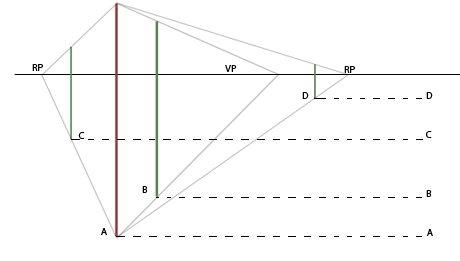Transferring Scale
Transferring Vertical Height
From last week you learned that transferring height of an object (diminution) is accomplished by drawing lines from the top and the bottom of the object, to the vanishing point on the eye level. Vertical lines drawn anywhere between those two diagonal lines create the same relative height of the object, creating the illusion of depth.

Transfer of Vertical Height: . The converging lines that touch the tops and bottoms of the red pole's original position and its new position meet on the horizon line at an arbitrary spot, which is called a Reference Point (RP).
Note: Arbitrary means that the Reference Point can be placed anywhere on the horizon line/eye level that you choose.

Position in Depth: Drawing horizontal lines from the base of each of the poles will indicate their position in depth. The closer the base of the poles are to the eye level the farther away they are. This is true for objects above and below the eye level.
Transferring Horizontal Length
You were also taught that transferring length of an object (diminution) is accomplished by drawing lines from both ends of the object to the vanishing point on the eye level. Horizontal lines drawn anywhere between those two diagonal lines create the same relative length of the object again creating the illusion of depth.

Transfer of Horizontal Length: The converging lines that touch the ends of the red pole’s original position and its new positions meet on the horizon line at a Reference Point (RP).
Note 1: Height and length can be transferred forward (closer to the viewer) or back (farther away from the viewer) using this principle.
Note 2: Slanted vertical lines and diagonal horizontal lines do not transfer the scale accurately—they represent lines that are greater in height or length than the original line.